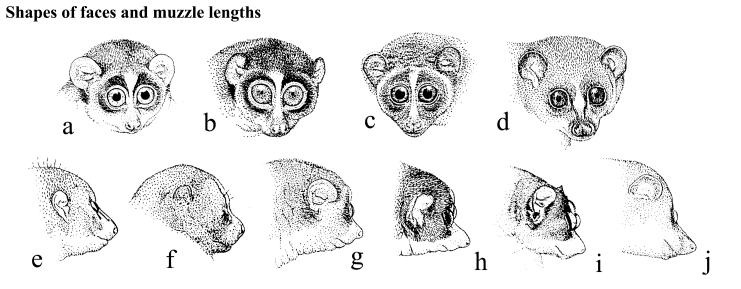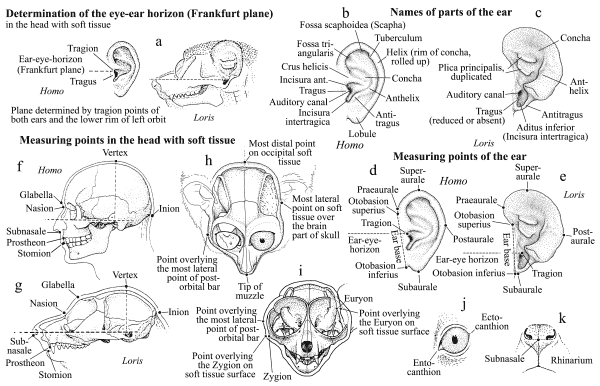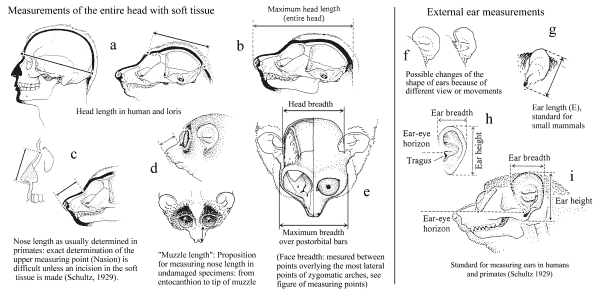
| Home |
|
|
|
|
Definitions for standardized measuring and description of the head with soft tissue and ears
Definitions of some parts and measuring points of the head with soft tissue
Ear measuring points
Measurements of the entire head with soft tissue, alphabetically
Ear measurements

Shape of the head and muzzle length
Figures redrawn from photos from Ruhr-University, Osman Hill 1953, Schultz 1971, S. Bearder and F. Wiens.
a-j: Examples for differences in the shape of face and muzzle
length:a,
f, g: more round-looking faces, a: with a more pointed
muzzle, e, f:
thicker muzzle (a, g: Loris; e: Perodicticus; f:
N. coucang).
b,
c, d, h, i, j: faces looking rather heart-shaped, giving the
impression
of a longer muzzle (a, g: Loris; d, j: Arctocebus).


Definitions
for
standardized measuring and description of the head with soft
tissue
and ears,
measurements found in loris and potto literature and some
propositions
for measurements
Definitions of planes of the head and skull, according to Schultz (1929) and Martin (1914), in alphabetical order:
Ear-eye horizon (= Frankfurt horizon, Frankfurt plane): plane determined by the lowest point of the left orbit, which can be determined by palpation, and the two tragion points (= upper edge of the tragus, where it runs into the cheek; if there is no tragus: upper rims of the openings of auditory canals) (Schultz 1929).
Midsagittal plane = median-sagittal plane: plane vertically dividing the head into two more or less symmetrical halves, approximately crossing the three points Nasion, Inion and Basion.
Definitions of further planes for head and skull measurements:
see Martin
1914, pp. 478-484.
Definitions of some parts and measuring points of the head with soft tissue, according to Schultz (1929) and Martin (1914):
Vertex: (head orientation: ear-eye-horizon horizontal): highest point of head in the midsagittal plane (Schultz 1929).
Inion: highest / most cranial point in the midsagittal plane to which neck muscles reach on the occipital bone (Schultz 1929).
Glabella: the most prominent point in the midsagittal plane between the superciliary arches (Schultz 1929).
Nasion: point on the surface of the entire head lying over the naso-frontal suture of the skull. In preserved specimens, this point can be determined by making an incision in the soft tissue and marking its location on the surface. In live specimens its exact determination is difficult, and measurements involving this point are therefore avoided as far as possible.
Subnasale: point in the midsagittal plane on the line connecting the lowest points of the nostrils (in most platyrrhines and other species); point in the midsagittal plane where the nasal septum merges into the upper lip (in humans); lowest midsagittal point of the nasal septum (in some primates) (Schultz 1929).
Stomion: point in which the midsagittal plane crosses the lip-cleft (mouth closed) (Schultz 1929).
Prostheon (Prosthion): point where the midsagittal plane crosses the upper visible edge of the incisors.
Palpebral fissure (Osman Hill, Phillips 1932), palpebral opening (Osman Hill 1942) = eye-cleft.
Ectocanthion: most lateral point of the palpebral fissure at the outer canthus of the eye (Schultz 1929).
Endocanthion: most medial point of the palpebral fissure at the inner canthus of the eye (should be placed at the medial end of the lacrimal caruncle) (Schultz 1929).
Point overlying the most lateral point of postorbital bar
(proposition,
no standard measurement known): most lateral point on the surface
of soft
tissue over the postorbital bars, for measuring maximum breadth of
the
head in the postorbital region instead of or in addition to face
breadth
(largest breadth measurement in species with large eyes and broad
postorbital
bars, but inconspicuous narrower zygomatic arch region).
Ear measuring points, head oriented in the ear-eye horizon (based on Schultz (1929) and Martin (1914).
Names of parts of the ear: see figure
Postaurale: the most posterior point on the helix (outer rim of the ear) (Schultz 1929)
Praeaurale: the most anterior point on the helix (outer ear rim) or on the base of the ear above the tragus (Schultz 1929). (Martin 1914, different definition, for humans only: point on the line connecting otobasion superius and otobasion inferius, altitude determined by altitude of the postaurale. Otobasion superius = point on the upper outer rim of the ear where it unites with the skin of head; otobasion inferius = point on the lower outer rim of the ear where it unites with the skin of cheek)
Subaurale: lowest point on the rim of the ear lobule or on the helix = outer ear rim; in some primates underneath the incisura intratragica (Schultz 1929)
Superaurale: the highest point on the helix (outer rim of
the
ear) (Schultz 1929)
(Martin 1914, for humans only: highest point on the rim of the
ear)
Tragion: point on the upper edge of the tragus, where it
runs
into the cheek; if there is no tragus: on the upper rim of the
opening
of auditory canals (Schultz 1929).
Measurements of the entire head with soft tissue, alphabetically:
Base length (Nasion-Inion-diameter), standard for primates and humans: from Nasion to Inion (Schultz 1929).
Base breadth (biauricular breadth), standard for primates and humans: straight distance between the right and left tragion. Represents the breadth of the base of skull plus soft tissue (Schultz 1929).
Biocular breadth: see outer eye breadth
Bizygomatic breadth: see face breadth
External palpebral breadth: see outer eye breadth
Face breadth (synonym: bizygomatic breadth), standard for primates and humans: usually greatest breadth between points overlying the zygomatic arches perpendicular to the midsagittal plane; zygomatic arches should be located by palpation (Schultz 1929). (Compare with the skull measurement "zygomatic breadth"). In Loris, because of the large eyes the broadest part of face is determined by the postorbital bar, in other species the zygomatic arch may be broader than the postorbital region, so it may make sense to measure both: see also "maximum breadth over postorbital bars".
Head breadth (synonym: maximum lateral diameter), standard
for
primates and humans: greatest breadth of the brain-part of head
over the
parietal or temporal bones, perpendicular to the midsagittal plane
(Schultz
1929).
(Compare with the skull measurement "breadth of braincase";
similar
to head breadth, but in this measurement soft tissue included).
Does not
represent the maximum head breadth in Loris because of the large
eyes.
Head length, standard for primates and humans: from glabella to the most distal point on the occiput in the mid-sagittal plain (Schultz 1929).
Height of palpebral opening(Osman Hill 1933; Osman Hill 1942): no definition found. Straight distance between most distant interior rim of upper and lower eyelid verical to the axis from entocanthion to extocanthion measured in the fully opened eye? (Data from Ruhr-University).
Inner eye breadth (synonyms: interocular breadth, internal palpebral breadth): distance between left and right endocanthion (Schultz 1929).
Interocular breadth: see inner eye breadth
Internal palpebral breadth: see inner eye breadth
Maximum breadth over postorbital bars: proposition (no standard measurement known): maximum horizontal distance of soft tissue surface overlying the postorbital bars (instead of or in addition to face breadth in species with large eyes and broad postorbital bars, but inconspicuous narrower zygomatic arch region). See also under "face breadth".
Maximum lateral diameter: see head breadth
Maximum length of head: from the tip of muzzle to the most distal part on the occiput (Schultz 1929).
Muzzle length: proposition from Ruhr-University instead of nose length for measuring in live / undamaged animals: from the median corners of the eye (enthocanthion) to the most distal edge of rhinarium on the same side of the head.
Nose breadth: greatest breadth of the nose between the nasal wings, perpendicular to the midsagittal plane; in species without nasal wing or without clearly defined border between nasal wing and cheek: greatest width between the lateral borders of nostrils including, if present, the slight rim around the nostrils (Schultz 1929).
Nose length in primates: see below, skull and head measurements; (can only be determined in dead specimens because exact determination of one of the measuring points is impossible without an incision in the soft tissue) (Schultz 1929)
Outer eye breadth (synonyms: biocular breadth, external palpebral breadth): straight distance between the right and left ectocanthion.
Palpebral fissure 23: see width of palpebral fissure.
Width of head (Singh et al. 1999) = head breadth? Or face breadth?
Width of palpebral fissure (synonym: palpebral fissure)23
= length of eyelid cleft from entocanthion to ectocanthion (Osman
Hill
1933) (Remark: may vary in living Loris specimens, as a
sign of
unwellbeing or tiredness the eye opening may become narrower with
the ectocanthion
drawn closer to the entocanthion (data from Ruhr-University).
Ear breadth (definition for primates, measured relatively to the ear-eye horizon): maximum distance measured parallel to the ear-eye horizon, from the most anterior point of the ear rim above the tragus to the most posterior point (Schultz 1929).
Ear height (definition for primates, according to Schultz, 1929: measured relatively to the ear-eye horizon. Definition of the ear-eye horizon: see figure showing skull and head measurements): maximum ear diameter measured perpendicular to the ear-eye horizon (including an ear lobule, if present) (Schultz 1929).
Ear length (E) (small mammal standard): Measurement from
the
base of the notch below the ear opening (lower rim of auditory
canal =
meatus) to the most distant point of the margin of the pinna
(external
ear), measured with calipers, dividers or a ruler. Hairs extending
the
tip of the ear not included.
|
Lorises and pottos: species,
subspecies, local
populations. In: http://www.species.net
|
Last amendment: 20 April 2001
|